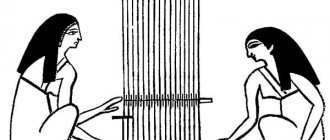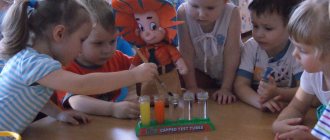Water in different states
Goal: to create conditions for children to become familiar with the properties of water. Objectives: Educational: introduce the properties of water: fluidity; the ability to dissolve bulk substances; the ability to take shape and move from one state to another; learn to conduct simple research; learn to look for answers, assume, draw conclusions; developmental: promote the development of children's creative research activity; develop coherent speech; educational: to develop the ability to work in a team, respect for water. Health-saving technologies: eye exercises, physical education, games. Interactive technologies – lesson presentation.
Source
Plan Water Sorceress
SAMPLE PLANNING OF EDUCATIONAL WORK (for the week
from 03/23/2020 to 03/27/20)
Group:
II senior group No. 2
Topic: “Water is a sorceress.”
Target:
Systematize children's knowledge about the properties and characteristics of water, its importance in human life, animals and plants.
To develop children’s cognitive interest, the desire to actively learn and act with natural objects. Develop a careful attitude towards water. Date of the final event: 03.26.20 Application “Aquarium” Responsible for the final event:
teachers,
| Day of the week | Main part | |||||
| Mode | Joint activities of adults and children, taking into account the integration of educational areas | Organization of a developmental environment for children’s independent activities (activity centers, all group rooms) | ||||
| Group, subgroup | Individual | Educational activities in special moments | ||||
| Morning: | Morning exercises Conversation “Water in our lives” To develop children’s knowledge about the importance of water in human life. D/i “Finish the sentence” - teach to understand the cause-and-effect relationships between phenomena, practice the correct selection of words - develop children’s thinking, memory, and speech. P/I “Ay water, water, water” clearly pronounce the words of the text | Individual work with Arina, Seryozha, Misha - To consolidate knowledge about emergency phone numbers, to continue to develop knowledge of life safety. | Duty in the dining room, strengthen the ability to correctly arrange cutlery. | Bring in and examine albums, books, illustrations of various water sources and reservoirs on Earth. | ||
| Monday 23.03.20 | GCD: 1 Cognition FCCM Topic: “Water and its inhabitants” N.S.Golitsyna from 340 | Goals: To provide knowledge about the importance of water in the life of humans, plants and animals, about its states (liquid, solid, gaseous). To clarify knowledge about aquatic inhabitants. To provide knowledge about the rules of safe behavior on water. To clarify knowledge about water sports and the benefits of water procedures for health. | ||||
| 2. Music | According to the specialist's plan. | |||||
| Walk I : | Watching the snow melt. Clarify ideas about the properties of water Work to scatter the snow (for quick melting), instill labor skills, and respect for birds. .P/i “Geese swans” to practice running, agility, and clearly pronounce words. | Work on HIA, game exercise “Snake”, “jumps”. Goal: to reinforce strict adherence to instructions. Involve Masha Ch, Vanya, Nadya. | Situational conversation “Beware of ice” - develop the ability to see danger, consolidate children’s knowledge of life safety | Using portable materials (spatulas, buckets), create conditions for the development of children’s work and play activities. Learn to play together. | ||
Lesson summary “Water Sorceress”
Children's age: 4-5 years
Goal : To develop in children knowledge about the properties of water and its meanings.
Tasks:
- Create a holistic understanding of water as a natural phenomenon;
- Introduce the properties of water (clear, tasteless);
- To make it clear about the importance of water in human life and in nature;
- Foster respect for water; teach to conserve natural resources;
- Enrich and activate the vocabulary;
- develop children's cognitive activity in the process of experimentation;
Methods: gaming, visual, verbal, practical.
Techniques: conversation, practical methods of action, exercise, game.
Preliminary work: Reading poems about water, nursery rhymes about washing, observations “Water is man’s friend”, “Birds drink water”, etc., experiments with water, conversations with children, examination and discussion of educational cards “Why do people need water”, simulation games.
Equipment: subject pictures, globe, transparent plastic glasses, containers with salt, sugar, oil, transparent jars, paints, brushes, surprise pictures.
Progress of the lesson:
Organizing time.
A game to create a positive emotional mood “Smile”
Educator: Let's hold hands. Let's smile at each other. To create a good mood.
Main part.
Listen, I’m now going to tell you a riddle, and if you guess it, we’ll find out the topic of our lesson:
It’s in the lake, It’s in the puddle, It’s boiling in our kettle, It’s also running and rustling in the river. What is this? (Water)
Guys, now let’s listen to you, what is that noise? listen and determine what these sounds are? (sounds of water) Q: Indeed, it’s a babbling stream. Tell me, why do we need water? (Children's answers) Who needs water? (Children's answers) Q. That's right, guys. Well done. We cannot live without water. Water can be very different. Water is rivers, lakes, seas. And also, water is necessary for everyone who lives on our planet Earth. (I draw the children’s attention to the globe, covered with a napkin and located in the middle of the circle): What are these children? (Globe, model of our planet - Earth). Q: What color is there more on the globe? (Blue) Q: What does the color blue mean? (water, seas, oceans, rivers).
Didactic game “Who needs water”
Q: Listen carefully to the conditions of the game: you need to choose from the sets of cards that depict those who need water and place them near the globe. Children explain who needs water. The teacher says that everyone needs water and it must be protected. Q: She, like a sorceress, can turn into dew, ice, snow, and can rain.
(I suggest you go into the laboratory and see how it rains from a cloud, (on the table in front of the children there are blue sponges and two bowls, one with water and the other empty. Let's imagine that this is our cloud. It is light. But if we If we wet it with water, it will become heavy. Wring out the sponge. What kind of droplets do we have? (large).)
Educator: Guys, where did you find water? (children's answers)
Physical education (Children squat down, the teacher walks around them with a watering can, imitating watering flowers)
Flowers of unprecedented beauty grow in the meadow. (Stretching - arms to the sides.) Flowers are reaching towards the sun. Stretch with them too. (Stretching - arms up.) The wind blows sometimes, but it’s not a problem. (Children wave their hands, imitating the wind.) The flowers bend down and lower their petals. (Tilts.)
And then they get up again and still bloom.
Q: Guys, now I suggest we come to the table. Look, guys, here's a glass, what kind of glass do we have? (clean, transparent) Q: Now, look, in front of you are cups and carafes of water. I suggest you pour the water into glasses.
Water is a liquid, we can pour it.
If we put a spoon in a glass of water. Look, can you see the spoon? (yes) Why can you see the spoon? (the water is clear) And now, guys, I suggest you taste the water. Take spoons and taste the water. What is she like? (water is tasteless) That's right, water has no taste. Now I suggest you smell the water, does the water smell of anything? (No, it doesn't smell) Q: Water has no smell. Guys, we learned that water has no taste, color or smell. Educator: Guys, I will ask you to come to my table. There are four saucers on my table, covered with napkins. To find out what lies there, you need to solve riddles.
Listen to the first riddle: A white stone melts in water. (Sugar). The teacher raises the napkin, the children check whether they guessed the riddle correctly.
Educator: Now the second riddle. Born in water, afraid of water. (Salt).
Remove the napkin from the second saucer.
Educator: And finally, the third and last riddle. Yellow, not the sun, It pours, not water, It foams in the frying pan, Splashes and hisses. (Oil).
You can bury something in it, I like to walk on it, and sleep on it for an hour. Guess what? - … (sand)
Educator: Guys, why are salt and sugar afraid of water? Children: Because they disappear in it. Educator: I suggest you all go to the tables and take part in the experiments.
The children are seated at their workplaces.
Educator: Let's see what happens to salt and sugar if we put them in water. Take two jars of water. Place a spoonful of granulated sugar in one and stir it with a spoon. What happens? Has sugar dissolved in water or not? Then, put salt in another jar. Stir it. The salt has disappeared. Why? Children: The salt dissolved in the water. Educator: Do you think all substances can dissolve in water? If you add oil to water, it will also disappear like sugar and salt. Add a few drops of oil to your jars of water.
Children are working independently.
The teacher asks what happened to the oil in the water. Children: The oil has not dissolved in the water: it floats on the surface of the water in yellow droplets. Educator: Well done guys. Having now conducted experiments with salt, sugar, oil, what new property of water have you become acquainted with? Children: Water can dissolve some substances, but not others. Conclusion: some substances dissolve in water, others do not dissolve at all.
WATER PURIFICATION
Voss: Guys, look again at that jar where we poured the oil. It remained floating on the surface of the water. Can you drink this water and why? Children: No. It smells like oil and tastes bad. Voss: Yes, indeed, such water is not suitable for drinking. What needs to be done to make it clean? Children: It needs to be cleaned of oil. Vos: And you know, this can be done, but only with the help of a filter. We can make the simplest filter for water purification ourselves from an ordinary napkin. Watch how I do this (show how to make a filter from a napkin and install it in a jar). Now try making a filter yourself. Independent work of children. Voss: Everything turned out right for everyone. Let's try how our filters work. We will very carefully, not much at a time, pour oily water into a jar with a filter. Children are working independently. Question: Carefully remove the filter and look at the water. What has she become? Children: The water has become clean. Voss: Where did the oil go? Children: All the oil remains on the filter. Voss: You and I have learned the easiest way to purify water. But we come across filtered water every day. The water that comes to us in our apartments through the water supply is also filtered. First, water is taken from a river or some underground reservoir. Then it goes to special water treatment plants, where, with the help of complex filters, not like ours, the water is purified from sand, dirt, and various microbes. And only after this does the water enter the water supply system.
A drop once, a drop two - flowed very slowly, And then then then Everyone ran, ran, ran, We will open our umbrellas, We will protect ourselves from the rain. Guys, tell me why we need water (we drink, wash our hands, cook food). Now I suggest you wash your hands. Tell us how you and I wash our hands. Our hands are clean, now we can drink tea, I suggest you sit down at the table, now we will brew tea, and again water will help us with this. Place the tea bag into the kettle. Fill with water while the tea is brewing and sum up.
- What is the model of our land called?
- what properties does water have?
- does it have a smell?
- does it taste?
Now let's drink tea.
Larikova Tatyana Vladimirovna teacher-defectologist, Moscow
Experimental research project “Water Sorceress”
Experimental research project “ Water in the Enchantress”
in the older group of compensatory orientation.
Project
passport 1. Type
of project
: research - creative.
2.Duration:
medium duration (2 months)
3.
Project
participants :
children of the older group of compensatory orientation, in
caregiver
4.Explanatory note.
Relevance of the topic:
Walking outside with the children in the fall, the children began to look at the puddles and became interested in the question of what kind of water
.
What happens to it in nature. We decided to understand the properties of water through experimentation. What properties does the sorceress – water –
?
The project was developed due to the particular relevance of the problem of educating preschoolers’ environmental culture.
The ecological state of our planet and the tendency towards its deterioration now require living people to understand the current situation and have a conscious attitude towards it.
The progressive deterioration of the health of adults and children is facilitated by various pollution of soil, water and air, as a result of which people eat poor-quality foods, drink bad water, and breathe air with a large admixture of exhaust gases.
The modern content of educational work with preschool children involves the humanization of the entire pedagogical process. A huge role in organizing this problem is assigned to the environmental education of children. Today, environmental awareness and respect for nature have become the key to human survival on our planet. In addition, environmental education for children has enormous potential for their comprehensive development.
The formation in children of knowledge about various natural phenomena should be combined with an understanding of the value of nature for society and people, with mastery of norms of behavior in the natural environment. This is achieved by solving the problems of educating the ecological culture of preschool children.
Fostering an ecological culture is a long way to developing the right ways to interact with nature. Understanding the elementary connections that exist in nature, a sense of empathy for everything, an effective readiness to create it, perception of the beauty of nature - these are the components of ecological culture. Children need to be taught the skills of environmentally conscious attitudes in everyday life and taught to use water carefully and economically. Pay attention to the fact that even such a familiar object as water is fraught with a lot of unknowns. All this emphasizes the relevance of this project.
The implementation of the “Water Sorceress” project is carried out in the process of organizing joint activities of adults and children in the afternoon according to long-term planning once a week. During the lesson, 2-3 experiments are carried out depending on the complexity in the form of a game - experimentation. The organization of experimental activities takes place in the form of a partnership between an adult and a child, which contributes to the child’s development of activity, independence, the ability to make a decision, to try to do something without fear that it will turn out wrong, evokes a desire to achieve, promotes emotional comfort, and the development of social and cognitive activity.





